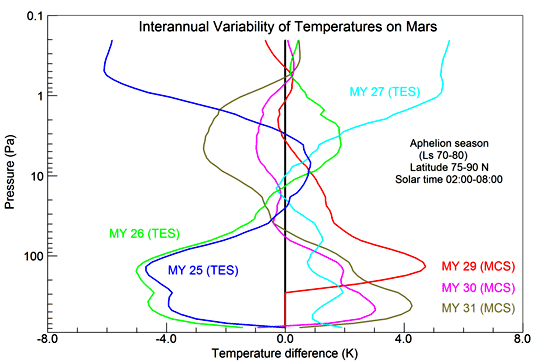David Kass • May 16, 2012
Third Martian Anniversary for Mars Climate Sounder
May 16, 2012 is the third martian anniversary of the start of Mars Climate Sounder (MCS) observations from the Mars Reconnaissance Orbiter. MCS started measuring the atmosphere of Mars three Mars years (687 days each) ago on September 24, 2006. This provides scientists working with the MCS data with the ability to compare the weather and behavior of the atmosphere in three different years. Just like on Earth, in some Mars years a given season is warmer or cooler than in others. This reflects the natural variability in the martian climate, much like the El Niño/La Niña phenomena affect the terrestrial climate. We climate scientists are currently working on understanding what drives Mars' interannual changes.
For the very dry and thin martian atmosphere, one of the key players is the amount of suspended dust. In general, the more dust in the atmosphere, the warmer it is. Mars has global dust storms in some years when the entire atmosphere is full of dust and almost none of the surface is visible, much like parts of Oklahoma during the dust bowl in the great depression. MCS observed one global storm in the summer of 2007 (at the end of Mars Year 28) where the dust was first lifted in late June and the atmosphere did not clear out again until mid-September.
The accompanying figure illustrates some of the year-to-year changes in the Mars atmosphere that are emerging from the analysis of MCS data along with that from other instruments, such as TES (the Thermal Emission Spectrometer on the Mars Global Surveyor Mission). The black line represents the average temperature for the 6 Mars Years investigated, while the colored curves give the departure from the average temperature as a function of pressure level (or altitude) for each year. (What's a Mars Year? Read this explainer.)

The temperature differences shown are surprisingly large (more than 8 Kelvin), in contrast to previous results. In an earlier study, Liu et al. (2003) noted that the aphelion season is associated with the lowest air temperatures, the lowest dust opacities, and the highest water ice cloud amounts of the year. These authors found that the year-to-year repeatability of the nighttime temperatures in their dataset was within 1-2 K (although daytime temperatures in the same season show more variability, of up to 4-6 K).
Support our core enterprises
Your support powers our mission to explore worlds, find life, and defend Earth. You make all the difference when you make a gift. Give today!
Donate

 Explore Worlds
Explore Worlds Find Life
Find Life Defend Earth
Defend Earth

